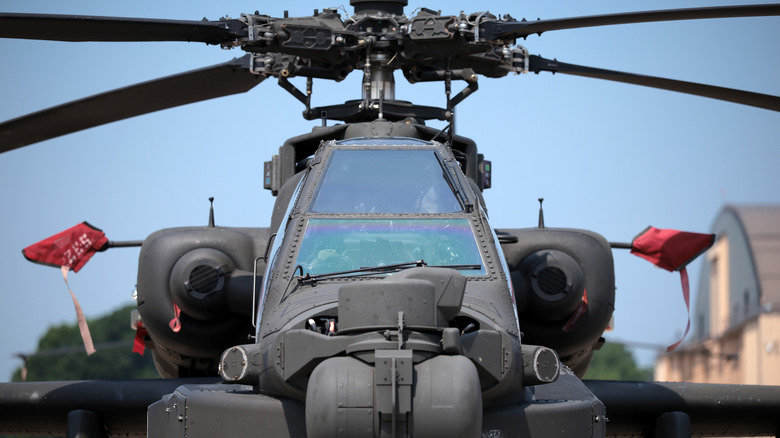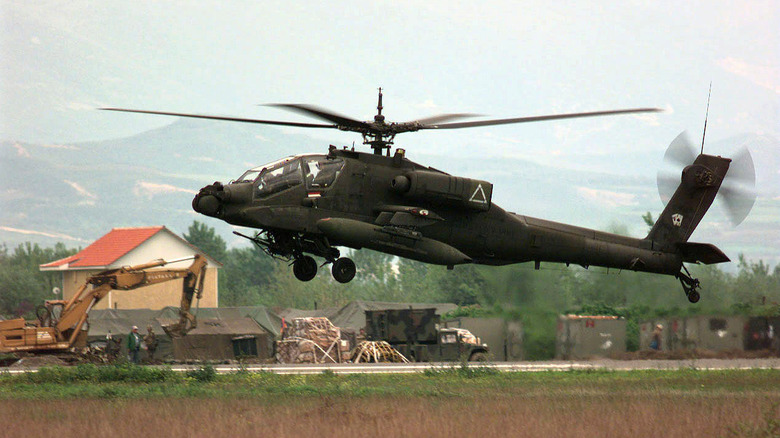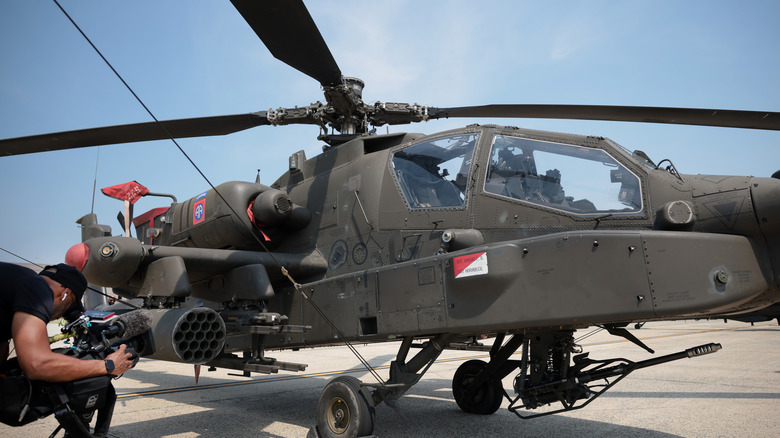Here's How Old The Boeing Apache Military Helicopter Is
Between its various branches, the United States military has created some of the most iconic vehicles in history. Naturally, some models have been promising prototypes that never made it to production, while others became legends for their sheer longevity. The M4 Sherman, for instance, dominated the battlefield long after World War II. Meanwhile, up in the air, another long-lived model is the AH-64 Apache attack helicopter.
The Apache was introduced some decades after the Sherman tank, making its first flight in September 1975. It was known as the YAH-64 then and designed by Hughes Helicopter Company. It was a crucial time for the military helicopter concept more broadly, as the U.S. sought to create a more advanced machine that could make the best use of a helicopter's maneuverability and versatility to deliver tremendous firepower. The Advanced Attack Helicopter program was implemented in mid-1972 to develop something more potent than the AH-1 Cobra.
Boeing delivered the first Apache, the AH-64A, in 1984, making it a 41-year-old attack helicopter, as of this writing. On the first model's delivery to the military that year, United States Chief of Army, General John A. Wickham Jr., sang its praises, noting (via Army Aviation magazine), "The Apache significantly enhances the attack helicopter fleet with its capability to kill tanks and other armored vehicles in day, night, or bad weather. Its responsiveness, survivability, and versatility adds to our ability to win on the battlefield."
The birth of a legendary helicopter
The Apache is rather fast for a military helicopter, reaching 164 knots, and quite imposing in size at about 57 feet in length, but the defining factor of this aircraft has always been the advanced technology it employs, primarily in terms of its arsenal. It was notably armed with up to 16 Hellfire missiles, effective up to 8,000 meters, as well as a fearsome primary weapon in the shape of the 30 mm M230A1, which can dispense up to 650 rounds in sixty seconds. It was typically equipped with GPS tech, as well as thermal and low-light imaging.
Approximately 937 of the first AH-64 models were developed, according to Boeing, and its earliest service took place during Operation Just Cause in Panama, followed by the Persian Gulf War in the early 1990s. It became so acclaimed for its power and pinpoint accuracy that, according to the U.S. Army, Just Cause Commander General Carl Stiner declared that the Apache "could fire that Hellfire missile through a window from four miles away at night."
The attack helicopter remains a powerhouse among military helicopters because it has evolved so effectively over its long service life. The family grew to include several variants, each of them potent in their own ways.
The Apache has a long past behind it, and a long future ahead
In 2000, Boeing issued a news release on the 25th anniversary of the prototype's first flight. Company vice president and general manager Martin Stieglitz gushed, "The Apache of today integrates the latest technologies, and we've been following a roadmap for technological growth that is designed to let us incorporate new systems as they emerge." He wasn't kidding. At that time, the newest variant was the AH-64D Apache Longbow, which incorporated Hellfire II missiles, improved communications systems, and the Longbow radar.
Its design was all about preparing it for a new era of warfare, so it remained relevant as times changed. The current model is the AH-64E, which boasts hardier rotors made of composite materials and engines that are more efficient and thereby less costly to run, on top of more sophisticated mechanics. It's not simply more powerful, it's also becoming more practical and advanced as technology has moved forward, and these factors have kept the model desirable, both domestically and internationally. In fact, Boeing lists 16 other countries outside the U.S. that have purchased the Apache, including the United Kingdom, Morocco, Greece, Saudi Arabia, Australia, and Japan.
According to the manufacturer, it has sent upwards of 2,700 Apaches to militaries around the world throughout the helicopter's more than four decades of service. The Version 6 architecture for the AH-64E gives it more versatility than ever, and as a result of its steady improvement, this iconic military helicopter is expected to continue to serve in its role into the 2060s, at least.


